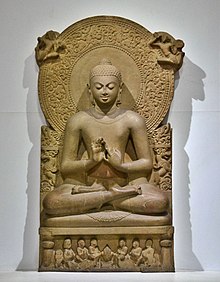
Back Siddhartha Gautama Afrikaans Siddhattha Gotama ALS ጎታማ ቡዳ Amharic Siddhartha Gautama AN Gautama Budda ANG गौतम बुद्ध ANP غوتاما بوذا Arabic ܒܘܕܗܐ ARC بوذا ARZ গৌতম বুদ্ধ Assamese
The Buddha | |
|---|---|
 Statue of the Buddha, preaching his first sermon at Sarnath. Gupta period, c. 5th century CE. Archaeological Museum Sarnath (B(b) 181)[a] | |
| Personal life | |
| Born | Siddhartha Gautama c. 563 BCE or 480 BCE |
| Died | c. 483 BCE or 400 BCE (aged 80)[1][2][3][c] |
| Resting place | Cremated; ashes divided among followers |
| Spouse | Yaśodharā |
| Children | Rāhula |
| Parents |
|
| Known for | Founding Buddhism |
| Other names | Gautama Buddha Shakyamuni (lit. 'Sage of the Shakyas') |
| Senior posting | |
| Predecessor | Kassapa Buddha |
| Successor | Maitreya |
| Part of a series on |
| Buddhism |
|---|
 |
Siddhartha Gautama,[e] most commonly referred to as the Buddha (lit. 'the awakened one'),[4][f][g] was a wandering ascetic and religious teacher who lived in South Asia,[h] during the 6th or 5th century BCE[5][6][7][c] and founded Buddhism. According to Buddhist legends, he was born in Lumbini, in what is now Nepal,[b] to royal parents of the Shakya clan, but renounced his home life to live as a wandering ascetic.[8][i] After leading a life of mendicancy, asceticism, and meditation, he attained nirvana at Bodh Gaya in what is now India. The Buddha then wandered through the lower Indo-Gangetic Plain, teaching and building a monastic order. Buddhist tradition holds he died in Kushinagar and reached parinirvana ("final release from conditioned existence").[9][j]
According to Buddhist tradition, the Buddha taught a Middle Way between sensual indulgence and severe asceticism,[10] leading to freedom from ignorance, craving, rebirth, and suffering. His core teachings are summarized in the Four Noble Truths and the Noble Eightfold Path, a training of the mind that includes ethical training and kindness toward others, and meditative practices such as sense restraint, mindfulness, dhyana (meditation proper). Another key element of his teachings are the concepts of the five skandhas and dependent origination, describing how all dharmas (both mental states and concrete 'things') come into being, and cease to be, depending on other dharmas, lacking an existence on their own svabhava).
A couple of centuries after his death, he came to be known by the title Buddha, which means 'Awakened One' or 'Enlightened One'.[11] His teachings were compiled by the Buddhist community in the Vinaya, his codes for monastic practice, and the Sutta Piṭaka, a compilation of teachings based on his discourses. These were passed down in Middle Indo-Aryan dialects through an oral tradition.[12][13] Later generations composed additional texts, such as systematic treatises known as Abhidharma, biographies of the Buddha, collections of stories about his past lives known as Jataka tales, and additional discourses, i.e., the Mahayana sutras.[14][15]
Buddhism evolved into a variety of traditions and practices, represented by Theravada, Mahayana and Vajrayana, and spread beyond the Indian subcontinent. While Buddhism declined in India, and mostly disappeared after the 8th century CE due to a lack of popular and economic support, Buddhism is more prominent in Southeast and East Asia.
Cite error: There are <ref group=lower-alpha> tags or {{efn}} templates on this page, but the references will not show without a {{reflist|group=lower-alpha}} template or {{notelist}} template (see the help page).
- ^ Cousins (1996), pp. 57–63.
- ^ Norman (1997), p. 33.
- ^ Prebish (2008).
- ^ *Laumakis, Stephen J. (2023). An Introduction to Buddhist Philosophy. Cambridge University Press. p. xii. ISBN 978-1-009-33708-3.
As far as we know, the man who became "the Buddha" or "the Awakened One" was neither a skeptic nor a fideist (i.e. a blind-faith believer) in religious and philosophical matters.
- Seager, Richard Hughes (2012). Buddhism in America. Columbia University Press. p. 19. ISBN 978-0-231-15973-9.
As a result of his discoveries, Siddhartha became known as the Buddha, the "awakened one" or "enlightened one."
- Davis, Richard H. (2020). "Religions of India in Practice". In Lopez, Donald S. (ed.). Asian Religions in Practice: An Introduction. Princeton University Press. p. 22. ISBN 978-0-691-21478-8.
Buddhists are those who follow the way of the buddhas, beings who have fully "awakened" (from the root budh, to wake up) to the true nature of things. In our historical era, the Awakened One was a kṣatriya Siddhartha Gautama, born in the foothills of the Himalaya Mountains in about 566 B.C.E.
- Seager, Richard Hughes (2012). Buddhism in America. Columbia University Press. p. 19. ISBN 978-0-231-15973-9.
- ^ Gethin (1998), pp. 5, 9, 10, 14.
- ^ Strong (2001), p. 1.
- ^ Warder (2000), p. 45.
- ^ Buswell & Lopez 2014, p. entry "Sakyamuni".
- ^ Bodhi 2005a, p. 51.
- ^ Laumakis (2008), p. 4.
- ^ Gethin (1998), p. 8.
- ^ Gethin (1998), pp. 40–41.
- ^ Warder (2000), pp. 4–7, 44.
- ^ Warder (2000), p. 4.
- ^ Cox (2003), p. 1–7.